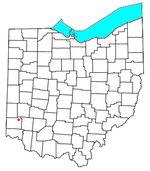Madison High School (Middletown, Ohio)
Greater Cincinnati school stubsHigh schools in Butler County, OhioPublic high schools in OhioPublic middle schools in Ohio

Madison Junior-Senior High School is a public high school near Middletown, Ohio. It is the only high school in the Madison Local Schools district. The school colors are red, black and white. Madison's sports teams, known as the Mohawks, participated in the Fort Ancient Valley Conference from 1979 until 1984, when the school left for the Southwestern Buckeye League's Buckeye Division, which consists of smaller schools.
Excerpt from the Wikipedia article Madison High School (Middletown, Ohio) (License: CC BY-SA 3.0, Authors, Images).Madison High School (Middletown, Ohio)
Middletown Eaton Road, Madison Township
Geographical coordinates (GPS) Address Nearby Places Show on map
Geographical coordinates (GPS)
| Latitude | Longitude |
|---|---|
| N 39.533888888889 ° | E -84.443055555556 ° |
Address
Madison Junior-Senior High School and Elementary School
Middletown Eaton Road
45042 Madison Township
Ohio, United States
Open on Google Maps









